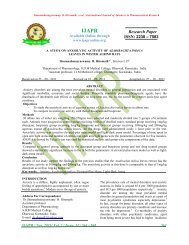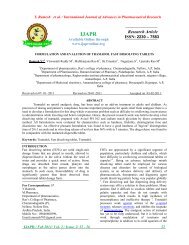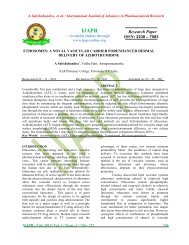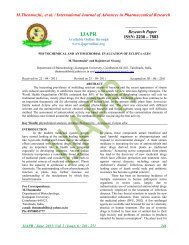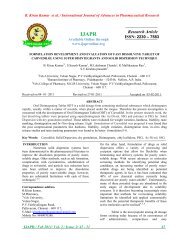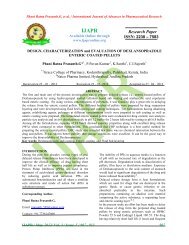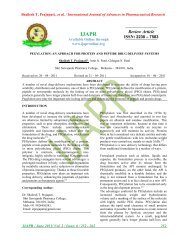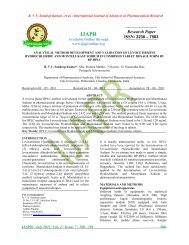ijapr - international journal of advances in pharmaceutical research
ijapr - international journal of advances in pharmaceutical research
ijapr - international journal of advances in pharmaceutical research
Create successful ePaper yourself
Turn your PDF publications into a flip-book with our unique Google optimized e-Paper software.
M.S Latha et al. / International Journal <strong>of</strong> Advances <strong>in</strong> Pharmaceutical Research<br />
IJAPR<br />
Available Onl<strong>in</strong>e through<br />
www.<strong>ijapr</strong>onl<strong>in</strong>e.org<br />
CHEMOPREVENTIVE EFFECT OF WOODFORDIA FRUTICOSA KURZ FLOWERS<br />
ON N-NITROSODIETHYLAMINE INDUCED HEPATOCELLULAR<br />
CARCINOMA IN RATS<br />
M.S Latha * , A. Nitha, P.N Ansil, S.P Prabha,<br />
Biochemistry and Pharmacognosy Research Laboratory, School <strong>of</strong> Biosciences,<br />
Mahatma Gandhi University, P.D. Hills P.O, Kottayam, Kerala-686560, India.<br />
Received on 21 – 10 - 2012 Revised on 22 – 11- 2012 Accepted on 02– 12 – 2012<br />
ABSTRACT<br />
To evaluate the chemopreventive effect <strong>of</strong> methanolic extract <strong>of</strong> Woodfordia fruticosa dried flowers on Nnitrosodiethylam<strong>in</strong>e<br />
<strong>in</strong>duced hepatocellular carc<strong>in</strong>oma <strong>in</strong> experimental rats. Two different doses <strong>of</strong> methanolic<br />
extract <strong>of</strong> Woodfordia fruticosa (MEWF 100mg/kg and 200mg/kg) were used to study the chemopreventive effect <strong>in</strong><br />
experimental rats aga<strong>in</strong>st N-nitrosodiethylam<strong>in</strong>e <strong>in</strong>duced hepatocellular carc<strong>in</strong>oma. NDEA (0.02%, 2ml,<br />
5days/week) was adm<strong>in</strong>istered to the rats <strong>in</strong> all groups except normal and drug control. Various serum parameters<br />
like aspartate am<strong>in</strong>otransferase (AST), alan<strong>in</strong>e am<strong>in</strong>otransferase (ALT) and gamma glutamyl transferase (GGT)<br />
were studied. The antioxidant status <strong>of</strong> liver was evaluated by us<strong>in</strong>g the follow<strong>in</strong>g parameters: - glutathione-Stransferase<br />
(GST), glutathione reductase (GR) and glutathione peroxidase (GPx). Immunohistochemical<br />
localizations <strong>of</strong> liver tissue for two important cancer markers: - Proliferat<strong>in</strong>g cell nuclear antigen (PCNA) and<br />
Cycl<strong>in</strong> D1 were evaluated. MEWF significantly (p ≤ 0.05) prevented the elevation <strong>of</strong> serum AST, ALT and GGT<br />
levels. Hepatic GST, GR and GPx levels were remarkably <strong>in</strong>creased by the treatment with the extract.<br />
Immunohistochemical analysis revealed the overexpression <strong>of</strong> proliferat<strong>in</strong>g cell nuclear antigen (PCNA) and cycl<strong>in</strong><br />
D1 <strong>in</strong> the liver tissue <strong>of</strong> rat <strong>in</strong>toxicated with NDEA. The overexpression was effectively reduced by the treatment<br />
with MEWF. This study demonstrates the chemopreventive effect <strong>of</strong> MEWF, and thus scientifically supports the<br />
use <strong>of</strong> this plant <strong>in</strong> traditional medic<strong>in</strong>e for the treatment <strong>of</strong> liver cancer.<br />
Keywords: Chemoprevention, Cycl<strong>in</strong> D1, N- nitrosodiethylam<strong>in</strong>e (NDEA), Proliferat<strong>in</strong>g cell nuclear antigen<br />
(PCNA), Silymar<strong>in</strong>, Woodfordia fruticosa.<br />
1. INTRODUCTION<br />
Hepatocellular carc<strong>in</strong>oma (HCC) is the fifth most<br />
common cancer worldwide and the third most<br />
common cause <strong>of</strong> mortality with a cont<strong>in</strong>uously<br />
<strong>in</strong>creas<strong>in</strong>g <strong>in</strong>cidence annually (1). Liver is an organ<br />
<strong>of</strong> paramount importance and it plays an essential<br />
role <strong>in</strong> drug and xenobiotic metabolism. Chronic<br />
<strong>in</strong>fection <strong>of</strong> hepatitis B and/ C, toxic <strong>in</strong>dustrial<br />
chemicals, aflatox<strong>in</strong> exposure <strong>in</strong> diets, cigarette<br />
smok<strong>in</strong>g, alcohol consumption, air and water<br />
pollutants etc are the major risk factors <strong>of</strong> liver<br />
diseases. Intake <strong>of</strong> acetam<strong>in</strong>ophen like drugs and<br />
certa<strong>in</strong> chemicals may also lead to hepatocellular<br />
carc<strong>in</strong>oma .Moreover, due to the high tolerance <strong>of</strong><br />
liver, HCC is seldom detected at the early stage and<br />
once detected treatment faces a poor prognosis <strong>in</strong><br />
most cases (2).<br />
Research Paper<br />
ISSN: 2230 – 7583<br />
N-nitrosodiethyalam<strong>in</strong>e (NDEA) is a potent<br />
hepatocarc<strong>in</strong>ogen <strong>in</strong> rats produc<strong>in</strong>g reproducible<br />
tumor after repeated adm<strong>in</strong>istration and is the most<br />
important environmental carc<strong>in</strong>ogen among N-niroso<br />
compounds. Adm<strong>in</strong>istration <strong>of</strong> NDEA to animals<br />
causes cancer <strong>in</strong> liver and at low <strong>in</strong>cidence <strong>in</strong> other<br />
organs also. It has been shown that the mechanism <strong>of</strong><br />
action is due to metabolism <strong>of</strong> NDEA to alkylat<strong>in</strong>g<br />
agents and reactive oxygen species and further<br />
<strong>in</strong>teraction with DNA molecule , form<strong>in</strong>g various<br />
DNA adducts that can lead to mutations (3). The O4 –<br />
ethyl deoxythimid<strong>in</strong>e adduct (O4- Etdt) accumulates<br />
<strong>in</strong> hepatocyte DNA follow<strong>in</strong>g NDEA adm<strong>in</strong>istration<br />
which is thought to be important <strong>in</strong> tumor <strong>in</strong>itiation<br />
(4).<br />
Hepatic chemical carc<strong>in</strong>ogenesis is a multistep<br />
process <strong>in</strong> experimental animals. Carc<strong>in</strong>ogens <strong>in</strong>itiate<br />
IJAPR / Dec. 2012/ Vol. 3 /Issue. 12 / 1322 – 1330 1322
M.S Latha et al. / International Journal <strong>of</strong> Advances <strong>in</strong> Pharmaceutical Research<br />
the process, which is followed by regeneration,<br />
growth and clonal proliferation, eventually lead<strong>in</strong>g to<br />
cancer (5). There is extensive evidence that the free<br />
radicals participate <strong>in</strong> NDEA <strong>in</strong>duced<br />
hepatocarc<strong>in</strong>ogenesis (6). Enzymes such as GST, GR<br />
and GPx reduce oxidative stress <strong>in</strong> the normal tissues.<br />
Extensive liver damage causes decrease <strong>in</strong> levels <strong>of</strong><br />
these enzymes suggest<strong>in</strong>g a high oxidative stress <strong>in</strong><br />
the tissues, which may be one <strong>of</strong> the key factors <strong>in</strong><br />
the etiology <strong>of</strong> cancer (7). They have been proved to<br />
cause numerous cellular anomalies, <strong>in</strong>clud<strong>in</strong>g but not<br />
limited to prote<strong>in</strong> damage, deactivation <strong>of</strong> enzymatic<br />
activity, alteration <strong>of</strong> DNA and lipid peroxidation <strong>of</strong><br />
membranes (8). Several herbal drugs like Abrus<br />
precatorius, Scutia myrt<strong>in</strong>a, Funaria <strong>in</strong>dica etc. have<br />
been evaluated for its potential as liver protectant<br />
aga<strong>in</strong>st NDEA <strong>in</strong>duced hepatocellular carc<strong>in</strong>oma <strong>in</strong><br />
rats (9- 11).<br />
Chemoprevention, which is referred to as the use <strong>of</strong><br />
nontoxic natural or synthetic chemicals to <strong>in</strong>tervene<br />
<strong>in</strong> multistage carc<strong>in</strong>ogenesis, has emerged as a<br />
promis<strong>in</strong>g and pragmatic medical approach to reduce<br />
the risk <strong>of</strong> cancer. Numerous components <strong>of</strong> plants,<br />
collectively termed “phytochemicals” have been<br />
reported to possess substantial chemopreventive<br />
properties. For many years cancer chemotherapy has<br />
been dom<strong>in</strong>ated by potent drugs that either <strong>in</strong>terrupt<br />
the synthesis <strong>of</strong> DNA or destroy its structure once it<br />
has formed. Unfortunately, their toxicity is not<br />
limited to cancer cells and normal cells are also<br />
harmed (12).<br />
Use <strong>of</strong> plants and plant derivatives considered as<br />
alternative medic<strong>in</strong>e for many ailments are on the<br />
<strong>in</strong>crease on a global perspective. Woodfordia<br />
fruticosa is a traditional medic<strong>in</strong>al plant belongs to<br />
the family Lythraceae is used aga<strong>in</strong>st a wide variety<br />
<strong>of</strong> diseases. All parts <strong>of</strong> the plant possess valuable<br />
medic<strong>in</strong>al properties such as anti <strong>in</strong>flammatory,<br />
antitumor, hepatoprotective and free radical<br />
scaveng<strong>in</strong>g activity but flowers are <strong>of</strong> maximum<br />
demand. Dried flowers are used as tonic <strong>in</strong> disorders<br />
<strong>of</strong> mucous membrane, hemorrhoids and <strong>in</strong><br />
derangement <strong>of</strong> liver (13). Phenolics, particularly<br />
hydrolysable tann<strong>in</strong>s and flavonoids were identified<br />
as major components <strong>in</strong> Woodfordia fruticosa<br />
flowers. In view <strong>of</strong> these the present study was<br />
undertaken to evaluate the chemopreventive effect <strong>of</strong><br />
Woodfordia fruticosa flower extract on NDEA<br />
<strong>in</strong>duced hepatocellular carc<strong>in</strong>oma <strong>in</strong> experimental<br />
rats.<br />
2. MATERIALS AND METHODS<br />
2.1 Chemicals<br />
N-nitrosodiethylam<strong>in</strong>e (NDEA), silymar<strong>in</strong>,<br />
proliferat<strong>in</strong>g cell nuclear antigen (PCNA), cycl<strong>in</strong> D1,<br />
anti-mouse IgG horse radish peroxidase, streptavid<strong>in</strong><br />
horse radish peroxidase conjugate and<br />
diam<strong>in</strong>obenzid<strong>in</strong>e were purchased from Sigma<br />
Chemical Co., St. Louis, MO, USA. Assay kits for<br />
serum aspartate am<strong>in</strong>otransferase (AST), alan<strong>in</strong>e<br />
am<strong>in</strong>otransferase (ALT) and gamma glutamyl<br />
transferase (GGT) were purchased from Agappe<br />
Diagnostics, India. All other chemicals were <strong>of</strong><br />
analytical grade.<br />
2.2 Collection <strong>of</strong> plant material and preparation <strong>of</strong><br />
plant extracts<br />
Woodfordia fruticosa flowers were collected from<br />
natural habitat (Kollam, Kerala, India) dur<strong>in</strong>g<br />
November - January. Plant material was identified by<br />
Dr. V.T Antony, S.B College. A voucher specimen<br />
(Acc. No. 7566) is deposited at the herbarium <strong>of</strong> the<br />
Department <strong>of</strong> Botany, S.B College, Changanassery,<br />
Kottayam, Kerala. Flowers were shade-dried and<br />
powdered and 50 g <strong>of</strong> dried powder was soxhlet<br />
extracted with 400 mL <strong>of</strong> methanol for 48 h. The<br />
extract was concentrated under reduced pressure<br />
us<strong>in</strong>g a rotary evaporator and was kept under<br />
refrigeration. The yield <strong>of</strong> methanolic extract <strong>of</strong><br />
Woodfordia fruticosa (MEWF) was 12.5 % (w/w).<br />
The concentrate was suspended <strong>in</strong> 5% Tween 80 for<br />
the present studies.<br />
2.3 Animals and diets<br />
Male Wistar rats weigh<strong>in</strong>g 150-160 gm were used <strong>in</strong><br />
this study. The animals were housed <strong>in</strong><br />
polypropylene cages and had free access to standard<br />
pellet diet (Sai Durga Feeds, Bangalore, India) and<br />
dr<strong>in</strong>k<strong>in</strong>g water. The animals were ma<strong>in</strong>ta<strong>in</strong>ed at a<br />
controlled condition <strong>of</strong> temperature <strong>of</strong> 26–28 o C with<br />
a 12 h light: 12 h dark cycle. Animal studies were<br />
followed accord<strong>in</strong>g to Institute Animal Ethics<br />
Committee regulations approved by Committee for<br />
the Purpose <strong>of</strong> Control and Supervision <strong>of</strong><br />
Experiments on Animals (Reg. No. B 2442009/4) and<br />
conducted humanely.<br />
2.4 Induction <strong>of</strong> hepatocellular carc<strong>in</strong>oma<br />
Hepatocellular carc<strong>in</strong>oma (HCC) was <strong>in</strong>duced by oral<br />
adm<strong>in</strong>istration <strong>of</strong> 0.02% NDEA (2ml, 5 days/week<br />
for 20 weeks (12). Silymar<strong>in</strong> at an oral dose <strong>of</strong> 100<br />
mg/kg body weight was used as standard control <strong>in</strong><br />
the experiment (14-15). Two different doses <strong>of</strong><br />
MEWF (100mg/kg and 200 mg/kg) suspended <strong>in</strong> 5%<br />
Tween 80 were prepared for oral adm<strong>in</strong>istration to<br />
the animals. It is reported that the extract <strong>of</strong> W.<br />
fruticosa flowers are safe up to the dose <strong>of</strong><br />
2000mg/kg, p.o (13).<br />
2.5 Experimental design<br />
IJAPR / Dec. 2012/ Vol. 3 /Issue. 12 / 1322 – 1330 1323
M.S Latha et al. / International Journal <strong>of</strong> Advances <strong>in</strong> Pharmaceutical Research<br />
Thirty six rats were divided <strong>in</strong>to six groups,<br />
Group I - Normal control<br />
Group II - NDEA control (0.02% NDEA, 2<br />
ml, 5days/week, p.o)<br />
Group III - Silymar<strong>in</strong> (100mg/kg b.w) +<br />
NDEA<br />
Group IV - MEWF (100mg/kg, b.w ) +<br />
NDEA<br />
Group V - MEWF (200mg/kg, b.w) + NDEA<br />
Group VI - MEWF (200 mg/kg) alone<br />
Daily doses <strong>of</strong> silymar<strong>in</strong> and MEWF treatments were<br />
started <strong>in</strong> groups III to V animals 1 week before the<br />
onset <strong>of</strong> NDEA adm<strong>in</strong>istration and cont<strong>in</strong>ued up to<br />
20 weeks. Group VI served as drug control received<br />
MEWF alone for the entire period. The rats were<br />
sacrificed 48 h after the last dose <strong>of</strong> NDEA<br />
adm<strong>in</strong>istration.<br />
2.6 Serum enzyme analysis<br />
Blood was collected from neck blood vessels and<br />
kept for 30 m<strong>in</strong> at 4 0 C. Serum was separated by<br />
centrifugation at 2500rpm at 4 0 C for 15 m<strong>in</strong>.<br />
Quantify<strong>in</strong>g the serum levels <strong>of</strong> aspartate<br />
am<strong>in</strong>otransferase (AST), alan<strong>in</strong>e am<strong>in</strong>otransferase<br />
(ALT) and gamma glutamyl transferase (GGT) by<br />
us<strong>in</strong>g a standard diagnostic kit (Agappe Diagnostic<br />
Ltd., India). Activities <strong>of</strong> these serum enzymes were<br />
measured by us<strong>in</strong>g semi autoanalyzer (RMS, India).<br />
2.7 Tissue analysis<br />
Liver tissue was excised, washed thoroughly <strong>in</strong> icecold<br />
sal<strong>in</strong>e to remove the blood. Then the dissected<br />
livers were cut <strong>in</strong>to separate portions for biochemical<br />
assays and immunohistochemical exam<strong>in</strong>ation.<br />
2.7.1 Biochemical assays<br />
Ten percent <strong>of</strong> homogenate was prepared <strong>in</strong> 0.1M<br />
Tris HCl buffer (pH – 7.4). The homogenate was<br />
centrifuged at 3000 rpm for 20 m<strong>in</strong> at 4 o C and the<br />
supernatant was used for the estimation <strong>of</strong><br />
glutathione-S-transferase (GST), glutathione<br />
reductase (GR), glutathione peroxidase (GPx) and<br />
total prote<strong>in</strong>.<br />
GST (EC 2.5.1.18) activity was determ<strong>in</strong>ed from the<br />
rate <strong>of</strong> <strong>in</strong>crease <strong>in</strong> conjugate formation between<br />
reduced glutathione and CDNB (16). GR (EC<br />
1.6.4.2) activity was assayed at 37 o C and 340 nm by<br />
follow<strong>in</strong>g the oxidation <strong>of</strong> NADPH by GSSG (17).<br />
GPx (EC 1.11.1.9) activity was determ<strong>in</strong>ed by<br />
measur<strong>in</strong>g the decrease <strong>in</strong> GSH content after<br />
<strong>in</strong>cubat<strong>in</strong>g the sample <strong>in</strong> the presence <strong>of</strong> H2O2 and<br />
NaN3 (18). Prote<strong>in</strong> content <strong>in</strong> the tissue was<br />
determ<strong>in</strong>ed us<strong>in</strong>g bov<strong>in</strong>e serum album<strong>in</strong> (BSA) as the<br />
standard (19).<br />
2.7.2 Immunohistochemical analysis<br />
Immunohistochemical analysis <strong>of</strong> the two cancer<br />
markers, namely proliferat<strong>in</strong>g cell nuclear antigen<br />
(PCNA) and Cycl<strong>in</strong> D1 were conducted.<br />
Tissue sections were deparaff<strong>in</strong>ised <strong>in</strong> three changes<br />
<strong>of</strong> xylene at 60 o C for 10m<strong>in</strong> each and hydrated<br />
through a graded series <strong>of</strong> alcohol. For antigen<br />
retrieval evaluation, slides were placed <strong>in</strong> citrate<br />
buffer (pH 6.0) for three cycles <strong>of</strong> 5 m<strong>in</strong> each <strong>in</strong> a<br />
microwave oven. The sections were then allowed to<br />
cool to room temperature and then r<strong>in</strong>sed with 1x tris<br />
buffered sal<strong>in</strong>e (TBS), and treated with 0.3% H2O2 <strong>in</strong><br />
water for 10 m<strong>in</strong> to block endogenous peroxidase<br />
activity. Non specific b<strong>in</strong>d<strong>in</strong>g was blocked with 3%<br />
BSA <strong>in</strong> room temperature for 1 h. Subsequently the<br />
primary antibody was applied at predeterm<strong>in</strong>ed<br />
dilutions (PCNA antibody diluted 1:500 / Cycl<strong>in</strong><br />
D1antibody diluted 1:80) with 1% BSA <strong>in</strong> PBS for<br />
overnight at 4 o C. After this <strong>in</strong>cubation washed thrice<br />
<strong>in</strong> PBS and <strong>in</strong>cubated with anti-mouse horseradish<br />
peroxidase for 45 m<strong>in</strong>. After triplicate wash<strong>in</strong>g with<br />
PBS, sections were <strong>in</strong>cubated for 30 m<strong>in</strong> with<br />
streptavid<strong>in</strong>–HRP complex. Then washed with PBS<br />
and <strong>in</strong>cubated for 5–10 m<strong>in</strong> <strong>in</strong> a solution <strong>of</strong><br />
diam<strong>in</strong>obenzid<strong>in</strong>e (6 mg/10mL 50mM Tris–HCl, pH<br />
7.6) conta<strong>in</strong><strong>in</strong>g 0.01% H2O2. Countersta<strong>in</strong><strong>in</strong>g was<br />
performed with hematoxyl<strong>in</strong>. Images were taken at<br />
orig<strong>in</strong>al magnification <strong>of</strong> 100× ( Motic AE 21,<br />
Germany and Moticam 1000 camera).<br />
2.8 Statistical analysis<br />
Results were expressed as mean ± S.D and all<br />
statistical comparisons were made by means <strong>of</strong> oneway<br />
ANOVA test followed by Tukey’s post hoc<br />
analysis and p-values less than or equal to 0.05 were<br />
considered significant.<br />
3. RESULTS<br />
3.1 Serum enzyme analysis<br />
The serum levels <strong>of</strong> AST, ALT, and GGT <strong>in</strong> group II<br />
were significantly (p ≤ 0.05) elevated by the<br />
adm<strong>in</strong>istration <strong>of</strong> NDEA, when compared to normal<br />
control. The treatment <strong>of</strong> MEWF at a dose <strong>of</strong> 100 and<br />
200 mg/kg showed a significant decrease (p ≤ 0.05)<br />
<strong>in</strong> AST, ALT, and GGT (Fig.1). Standard control<br />
drug, Silymar<strong>in</strong> at a dose <strong>of</strong> 100 mg/kg also<br />
prevented the elevation <strong>of</strong> serum enzymes. Treatment<br />
with MEWF at 200 mg/kg and Silymar<strong>in</strong> exhibited a<br />
protection <strong>of</strong> 98% and 80.7% <strong>in</strong> AST levels, 97% and<br />
88% <strong>in</strong> ALT levels and 98.2% and 84% <strong>in</strong> GGT<br />
levels, respectively.<br />
3.2 Liver morphology<br />
Fig.2 shows the morphological variations <strong>of</strong> rat livers<br />
<strong>in</strong> different experimental groups. NDEA treated rat<br />
IJAPR / Dec. 2012/ Vol. 3 /Issue. 12 / 1322 – 1330 1324
M.S Latha et al. / International Journal <strong>of</strong> Advances <strong>in</strong> Pharmaceutical Research<br />
liver (Fig.2B) is morphologically different from<br />
normal liver. In NDEA treated groups rat liver<br />
become very large <strong>in</strong> size and a large number <strong>of</strong><br />
hepatic nodules were observed <strong>in</strong> the liver. In MEWF<br />
200mg/kg treated group and <strong>in</strong> MEWF alone treated<br />
groups liver morphology is very similar to normal<br />
rats.<br />
3.3 Tissue biochemical analysis<br />
3.3.1 Estimation <strong>of</strong> Glutathione - S - transferase<br />
(GST)<br />
The GST activity <strong>of</strong> liver tissues were significantly (p<br />
≤ 0.05) reduced <strong>in</strong> NDEA <strong>in</strong>toxicated rats <strong>of</strong> pretreatment<br />
groups compared to normal control. The<br />
MEWF dose dependently <strong>in</strong>creased (p ≤ 0.05) the<br />
activity <strong>of</strong> GST <strong>in</strong> hepatic tissues (Table 1).<br />
Treatment with 200 mg/kg methanolic extract<br />
exhibited prom<strong>in</strong>ently <strong>in</strong>creased i.e., 89.9% GST<br />
levels. In addition, Silymar<strong>in</strong> treated rats also<br />
prevented the NDEA <strong>in</strong>duced decrease <strong>in</strong> GST<br />
activity by 69.9% <strong>in</strong> hepatic tissue.<br />
3.3.2 Estimation <strong>of</strong> Glutathione Reductase (GR)<br />
GR activity was significantly decreased (p ≤ 0.05) <strong>in</strong><br />
NDEA treated animals when compared to control. A<br />
significant <strong>in</strong>crease (p ≤ 0.05) <strong>in</strong> the level <strong>of</strong> GR was<br />
observed <strong>in</strong> MEWF (100 and 200 mg/kg) and<br />
Silymar<strong>in</strong> (100 mg/kg) treated rats <strong>in</strong>toxicated with<br />
NDEA (Table 1). The percentage <strong>of</strong> protection <strong>in</strong> liver<br />
tissue was 83.8% for 200 mg/kg <strong>of</strong> MEWF. Silymar<strong>in</strong><br />
restored the GR activity up to 62.6% <strong>in</strong> rat liver.<br />
3.3.3 Estimation <strong>of</strong> Glutathione Peroxidase (GPx)<br />
Activities <strong>of</strong> hepatic GPx was significantly (p ≤ 0.05)<br />
lowered <strong>in</strong> NDEA treated rats (Table 1). MEWF dose<br />
dependently prevented the lower<strong>in</strong>g <strong>of</strong> GPx<br />
compared to NDEA alone treated groups. In liver,<br />
200 mg/kg <strong>of</strong> methanolic extract showed a protection<br />
<strong>of</strong> 94.5%. Silymar<strong>in</strong>-treated rats also prevented the<br />
lower<strong>in</strong>g <strong>of</strong> GPx by 73.3% <strong>in</strong> hepatic tissues.<br />
3.4 Immunohistochemical analysis<br />
Fig. 3 and 4 shows the immunohistochemical<br />
analysis <strong>of</strong> PCNA and Cycl<strong>in</strong> D1 respectively. Here<br />
normal rat tissue showed regularly sta<strong>in</strong>ed nucleus.<br />
NDEA adm<strong>in</strong>istered rat liver tissue showed<br />
overexpression <strong>of</strong> Proliferat<strong>in</strong>g Cell Nuclear Antigen<br />
(PCNA) and Cycl<strong>in</strong> D1. Adm<strong>in</strong>istration <strong>of</strong> MEWF<br />
showed a reduction <strong>in</strong> the expression <strong>of</strong> PCNA and<br />
Cycl<strong>in</strong> D1. PCNA is a common <strong>in</strong>dex for<br />
proliferation <strong>of</strong> hepatocytes at late G1 stage and early<br />
S stage. Fig. 3B and 4B (HCC bear<strong>in</strong>g) groups<br />
sta<strong>in</strong>ed positively for PCNA and Cycl<strong>in</strong> D1<br />
<strong>in</strong>dicat<strong>in</strong>g active cell proliferation when compared<br />
with normal control. The plant extract given at a<br />
concentration <strong>of</strong> 200mg/kg showed a remarkable<br />
lower<strong>in</strong>g <strong>of</strong> the expression <strong>of</strong> PCNA and cycl<strong>in</strong> D1<br />
and was comparable to the effect rendered by<br />
silymar<strong>in</strong> at a concentration <strong>of</strong> 100mg/kg.<br />
4. DISCUSSION<br />
Abnormal proliferation <strong>of</strong> cells is the ma<strong>in</strong> feature <strong>of</strong><br />
carc<strong>in</strong>ogenesis, and there for exploration <strong>of</strong> drugs<br />
that can affect malignant proliferation <strong>of</strong> liver cells is<br />
<strong>of</strong> primary importance <strong>in</strong> chemical prevention <strong>of</strong> liver<br />
cancer. PCNA present <strong>in</strong> cell nucleus is directly<br />
<strong>in</strong>volved <strong>in</strong> DNA replication. It has been found that<br />
the positive expression <strong>of</strong> PCNA were a common<br />
<strong>in</strong>dex for proliferation <strong>of</strong> hepatocytes at late G1 stage<br />
and early S stage (20). The positive expression <strong>of</strong><br />
prote<strong>in</strong>s was ma<strong>in</strong>ly found <strong>in</strong> the precancerous<br />
proliferation focus and cancerous liver tissue dur<strong>in</strong>g<br />
NDEA <strong>in</strong>duced hepatocarc<strong>in</strong>ogenesis. The high<br />
expression <strong>of</strong> PCNA <strong>in</strong> the present studies suggested<br />
that the ability <strong>of</strong> cell proliferation become stronger,<br />
and this was closely related to malignant cell<br />
proliferation and carc<strong>in</strong>ogenesis (21). The results<br />
<strong>in</strong>dicated that the adm<strong>in</strong>istration <strong>of</strong> MEWF could<br />
remarkably decrease the PCNA <strong>in</strong> HCC bear<strong>in</strong>g<br />
tissue, suggest<strong>in</strong>g that MEWF had the ability to<br />
suppress malignant proliferation <strong>of</strong> hepatocytes <strong>in</strong><br />
experimental liver cancer and <strong>in</strong>hibited tumor growth<br />
through <strong>in</strong>hibition <strong>of</strong> DNA synthesis.<br />
Cycl<strong>in</strong> D1 is another important cancer marker has<br />
been associated with a variety <strong>of</strong> cancers <strong>in</strong>clud<strong>in</strong>g<br />
HCC. Cycl<strong>in</strong> D1 is the regulatory subunit <strong>of</strong> a<br />
holoenzyme that promotes progression through the<br />
G1-S phase <strong>of</strong> cell cycle. Amplification or<br />
overexpression <strong>of</strong> Cycl<strong>in</strong> D1 plays important roles <strong>in</strong><br />
the development <strong>of</strong> a subset <strong>of</strong> human tumorigenesis<br />
and cellular metastasis (22).<br />
Am<strong>in</strong>o transferases (AST, ALT) and GGT are the<br />
important cytoplasmic enzymes present <strong>in</strong> the liver.<br />
Dur<strong>in</strong>g chemical <strong>in</strong>toxication the membrane <strong>in</strong>tegrity<br />
is lost due to necrosis and these enzymes move <strong>in</strong>to<br />
the circulatory system followed by elevated levels <strong>of</strong><br />
enzymes <strong>in</strong> the serum (23). Increased levels <strong>of</strong> serum<br />
AST, ALT and GGT was detected <strong>in</strong> NDEA treated<br />
rats, effectively down- regulated by the treatment<br />
with MEWF <strong>in</strong>dicat<strong>in</strong>g the protective role <strong>of</strong><br />
Woodfordia fruticosa <strong>in</strong> NDEA <strong>in</strong>duced HCC.<br />
The <strong>in</strong>tra cellular antioxidant system comprises <strong>of</strong><br />
different free radical scaveng<strong>in</strong>g antioxidant enzymes<br />
such as GST, GR and GPx constitute the first l<strong>in</strong>e <strong>of</strong><br />
cellular antioxidant defense system. When excess<br />
free radicals are produced, the equilibrium is lost and<br />
consequently oxidative <strong>in</strong>sult is established (24).<br />
GST <strong>of</strong>fers protection aga<strong>in</strong>st lipid peroxidation by<br />
promot<strong>in</strong>g the conjugation <strong>of</strong> toxic electrophiles with<br />
GSH (25). GR is also essential for the ma<strong>in</strong>tenance <strong>of</strong><br />
IJAPR / Dec. 2012/ Vol. 3 /Issue. 12 / 1322 – 1330 1325
M.S Latha et al. / International Journal <strong>of</strong> Advances <strong>in</strong> Pharmaceutical Research<br />
GSH levels <strong>in</strong> vivo. The significant (p ≤ 0.05)<br />
restoration <strong>of</strong> GPx activity <strong>in</strong> MEWF and silymar<strong>in</strong><br />
might be due to the antioxidant activity by<br />
detoxify<strong>in</strong>g the endogenous metabolic peroxides<br />
generated after NDEA <strong>in</strong>toxication <strong>in</strong> hepatic tissues.<br />
These biochemical restorations may be due to the<br />
<strong>in</strong>hibitory effects <strong>of</strong> MEWF <strong>in</strong> the process <strong>of</strong> cellular<br />
damage <strong>in</strong> the liver. Free radical scaveng<strong>in</strong>g activity<br />
<strong>of</strong> Woodfordia fruticosa methanolic extract<br />
is well established and that effectively protects the liver aga<strong>in</strong>st carbon tetrachloride [13], dicl<strong>of</strong>enac (26)<br />
thioacetamide (27) and phenyto<strong>in</strong> (28) <strong>in</strong>duced hepatotoxicity <strong>in</strong> rats.<br />
Prelim<strong>in</strong>ary phytochemical analysis identified the major class <strong>of</strong> chemical components present <strong>in</strong> methanolic extract<br />
are sapon<strong>in</strong>s (steroids and terpenes), phenolics, alkaloids, flavanoids, tann<strong>in</strong>s etc. The phytochemicals identified are<br />
more potent <strong>in</strong> <strong>in</strong>hibit<strong>in</strong>g free radicals and this could be protective aga<strong>in</strong>st the progression <strong>of</strong> NDEA <strong>in</strong>duced HCC.<br />
The compounds reported from the dried flowers <strong>of</strong> Woodfordia fruticosa are β-sitosterol, kaempferol, ellagic acid,<br />
octacosanol, meso-<strong>in</strong>ositol, quercet<strong>in</strong>, woodford<strong>in</strong>s A, B, C, oenothe<strong>in</strong> B, woodford<strong>in</strong> D and oenothe<strong>in</strong> A (29).<br />
Ellagic acid is a compound reported to have chemopreventive effect and is useful <strong>in</strong> <strong>in</strong>flammatory disorders like<br />
colorectal cancer (30). Quercet<strong>in</strong> is a plant derived Flavanoid, used <strong>in</strong> cancer prevention and treatment. Anti<strong>in</strong>flammatory<br />
effect <strong>of</strong> quercet<strong>in</strong> <strong>in</strong> hepatoma cell l<strong>in</strong>es (Hep G2) was reported (31). Woodford<strong>in</strong> C and oenothe<strong>in</strong> B,<br />
a class <strong>of</strong> macrocyclic hydrolysable tann<strong>in</strong>s exhibited potent host-mediated antitumor activity aga<strong>in</strong>st sarcoma 180<br />
<strong>in</strong> mice (32-33). Woodford<strong>in</strong> C shows remarkable <strong>in</strong>hibition <strong>of</strong> DNA topoisomerase II (34). Woodford<strong>in</strong> D and<br />
Oenothe<strong>in</strong> A, trimeric hydrolysable tann<strong>in</strong>s also have antitumor activity (35). Thus protection yielded by this extract<br />
may be due to the comb<strong>in</strong>ed effects <strong>of</strong> these compounds or fractions rather than any s<strong>in</strong>gle component.<br />
AND FIGURES<br />
Table 1: Effect <strong>of</strong> MEWF on GST, GR and GPx <strong>in</strong> the liver tissue <strong>of</strong> different experimental groups<br />
Treatment groups<br />
Normal control<br />
NDEA control (0.02%)<br />
Silymar<strong>in</strong>(100mg/kg)+<br />
NDEA<br />
MEWF(100mg/kg)+ NDEA<br />
MEWF(200mg/kg)+ NDEA<br />
MEWF alone<br />
GST 1<br />
72.5±0.70<br />
33.1±0.43 *<br />
58.3±0.52 **<br />
53.9±0.78 **<br />
68.5±0.51 **<br />
70.2±0.53 **<br />
1: μmol CDNB-GSH conjugate formed/m<strong>in</strong>/mg prote<strong>in</strong> ; 2 : nmol <strong>of</strong> GSSG utilized/m<strong>in</strong>/mg prote<strong>in</strong>; 3: nmol <strong>of</strong> GSH<br />
oxidized/m<strong>in</strong>/mg prote<strong>in</strong><br />
Values are mean± S.D., n=6<br />
* p≤ 0.05 versus normal control<br />
** p≤ 0.05 versus NDEA control<br />
GR 2<br />
21.4±0.77<br />
7.2±0.38 *<br />
16.16±0.43 **<br />
12.3±0.45 **<br />
19.15±0.83 **<br />
21.7±0.61 **<br />
GPx 3<br />
283.1±2.85<br />
162.4±3.09 *<br />
250.8±3.05 **<br />
217.5±2.51 **<br />
276.4±3.81 **<br />
281.8±3.0 **<br />
IJAPR / Dec. 2012/ Vol. 3 /Issue. 12 / 1322 – 1330 1326
M.S Latha et al. / International Journal <strong>of</strong> Advances <strong>in</strong> Pharmaceutical Research<br />
Fig.1. Effects <strong>of</strong> MEWF on changes <strong>in</strong> serum enzyme levels <strong>of</strong> rats treated with NDEA.<br />
Fig. (A) Aspartate am<strong>in</strong>otransferase, (B) Alan<strong>in</strong>e am<strong>in</strong>otransferase and (C) Gamma glutamyl transferase. (I) Normal<br />
control, (II) NDEA control (III) Silymar<strong>in</strong> + NDEA, (IV) MEWF (100 mg/kg) + NDEA (V) MEWF (200 mg/kg) +<br />
NDEA, (VI) MEWF alone. Values are mean ± S.D, error bar <strong>in</strong>dicat<strong>in</strong>g the standard deviation, n = 6 animals. * p ≤<br />
0.05 vs. normal control. **p ≤ 0.05 vs. NDEA control.<br />
Fig.2. Morphological variations <strong>of</strong> liver <strong>in</strong> control and treated rats<br />
Fig.2 (A) Normal control; (B) NDEA control (0.02%); (C) Silymar<strong>in</strong> (100 mg/kg) + NDEA; (D) MEWF (100<br />
mg/kg) + NDEA; (E) MEWF (200 mg/kg) + NDEA and (F) MEWF (200mg/kg) alone.<br />
IJAPR / Dec. 2012/ Vol. 3 /Issue. 12 / 1322 – 1330 1327
M.S Latha et al. / International Journal <strong>of</strong> Advances <strong>in</strong> Pharmaceutical Research<br />
Fig. 3. Immunohistochemical localizations <strong>of</strong> PCNA <strong>in</strong> control and treated groups.<br />
Fig. 3. Liver tissue was immunosta<strong>in</strong>ed for PCNA followed by sta<strong>in</strong><strong>in</strong>g with hemetoxil<strong>in</strong> (100x). (A) Normal<br />
control; (B) NDEA control (0.02%); (C) Silymar<strong>in</strong> (100 mg/kg) + NDEA; (D) MEWF (100 mg/kg) + NDEA;<br />
(E) MEWF (200 mg/kg) + NDEA and (F) MEWF (200mg/kg) alone.<br />
Fig. 4. Immunohistochemical localizations <strong>of</strong> Cycl<strong>in</strong> D1 <strong>in</strong> control and treated groups<br />
Fig. 4. Liver tissue was immunosta<strong>in</strong>ed for Cycl<strong>in</strong> D1 (<strong>in</strong>dicated by brown sta<strong>in</strong>ed nuclei) followed by sta<strong>in</strong><strong>in</strong>g with<br />
hemetoxil<strong>in</strong> (100x). (A) Normal control; (B) NDEA control (0.02%); (C) Silymar<strong>in</strong> (100 mg/kg) + NDEA; (D)<br />
MEWF (100 mg/kg) + NDEA; (E) MEWF (200 mg/kg) + NDEA and (F) MEWF (200mg/kg) alone.<br />
IJAPR / Dec. 2012/ Vol. 3 /Issue. 12 / 1322 – 1330 1328
M.S Latha et al. / International Journal <strong>of</strong> Advances <strong>in</strong> Pharmaceutical Research<br />
CONCLUSION<br />
The results presented <strong>in</strong> this study <strong>in</strong>dicate that the<br />
HCC <strong>in</strong>duced by N-nitrosodiethylam<strong>in</strong>e was<br />
effectively <strong>in</strong>hibited by the treatment with MEWF at<br />
a dose <strong>of</strong> 200 mg/kg, b.w. When compared to<br />
standard drug silymar<strong>in</strong> treated group, the MEWF<br />
treated group showed better efficacy towards NDEA<br />
<strong>in</strong>duced hepatocellular carc<strong>in</strong>oma. In rats treated with<br />
MEWF alone no significant change was observed.<br />
The pretreatment with MEWF on pathological<br />
conditions <strong>in</strong> chronic hepatic disorder such as HCC<br />
showed remarkable protection; provide a new<br />
approach to study the active pr<strong>in</strong>ciple responsible for<br />
chemoprevention <strong>in</strong> tumor models. However further<br />
work is required for the fractionation <strong>of</strong> MEWF and<br />
identification <strong>of</strong> the active compound which is<br />
underway.<br />
Conflict <strong>of</strong> <strong>in</strong>terest statement<br />
We declare that we have no conflict <strong>of</strong> <strong>in</strong>terest.<br />
Acknowledgments<br />
F<strong>in</strong>ancial assistance from Mahatma Gandhi<br />
University as Junior Research Fellowship to Nitha<br />
Anand is thankfully acknowledged. Authors also<br />
thankful to Dr. P.J Wills, Scientist, MIMS <strong>research</strong><br />
foundation, Calicut., Ms. Jyothi Lekshmi M,<br />
Research scholar, SBS, M. G. University, Kottayam<br />
and Ms. Reshmi Radhakrishnan, project staff, SBS,<br />
M.G University, Kottayam for their help <strong>in</strong> this work.<br />
REFERENCES<br />
(1) Park<strong>in</strong> DM, Bray F, Ferlay J, Pisani P., Global cancer<br />
statistics, 2002. CA: A Cancer Journal <strong>of</strong> Cl<strong>in</strong>icians 2005,<br />
55, 74-108.<br />
(2) S<strong>in</strong>gh BN, S<strong>in</strong>gh BR, Sarma BK, S<strong>in</strong>gh HB., Potential<br />
chemoprevention <strong>of</strong> N- nitrosodiethylam<strong>in</strong>e-<strong>in</strong>duced<br />
hepatocarc<strong>in</strong>ogenesis by polyphenolics from Acacia<br />
nilotica bark. Chemico Biological Interactions 2009, 181,<br />
20–28.<br />
(3) Jeena KJ, Joy KL, Kuttan R., Effect <strong>of</strong> Emblica <strong>of</strong>fic<strong>in</strong>alis,<br />
Phyllanthus amarus and Picrorrhiza kurroa on Nnitrosodiethylam<strong>in</strong>e<br />
<strong>in</strong>duced hepatocarc<strong>in</strong>ogenesis.<br />
Cancer Letters 1999, 136, 11-16.<br />
(4) Sivalokanathan S, Ilayaraja M, Balasubramanian MP.,<br />
Antioxidant activity <strong>of</strong> Term<strong>in</strong>alia arjuna bark extract on<br />
N-nitrosodiethyl am<strong>in</strong>e <strong>in</strong>duced hepatocellular carc<strong>in</strong>oma<br />
<strong>in</strong> rats. Molecular and Celularl Biochemistry 2006, 281,<br />
87-93.<br />
(5) Goldworthy TL, Pitot HC., An approach to the<br />
development <strong>of</strong> a short term whole animal<br />
bioassay to dist<strong>in</strong>guish <strong>in</strong>itiat<strong>in</strong>g agents (<strong>in</strong>complete<br />
carc<strong>in</strong>ogens), promot<strong>in</strong>g agents, complete carc<strong>in</strong>ogens,<br />
and noncarc<strong>in</strong>ogens <strong>in</strong> rat liver. Journal <strong>of</strong> Toxicology and<br />
Environmental Health 1985, 16, 389–402.<br />
(6) Nakae D, Kobayashi Y, Akai H, Andoh N, Satoh H,<br />
Ohashi K, Tsutsumi M, Konishi Y., Involvement <strong>of</strong> 8hydroxyguan<strong>in</strong>e<br />
formation <strong>in</strong> the <strong>in</strong>itiation <strong>of</strong> rat liver<br />
carc<strong>in</strong>ogenesis by low dose levels <strong>of</strong> Nnitrosodiethylam<strong>in</strong>e.<br />
Cancer Research 1997, 57, 1281–<br />
1287.<br />
(7) Bansal AK, Bansal M, Soni G, Bhatnagar D., Protective<br />
role <strong>of</strong> Vitam<strong>in</strong> E pre-treatment on N-nitrosodiethylam<strong>in</strong>e<strong>in</strong>duced<br />
oxidative stress <strong>in</strong> rat liver. Chemico Biological<br />
Interactions 2005, 156, 101–111.<br />
(8) Beckman JS, Beckman TW, Chen J, Marshall PA,<br />
Freeman BA., Apparent hydroxyl radical production by<br />
peroxynitrite: implications for endothelial <strong>in</strong>jury from<br />
nitric oxide and superoxide. Proceed<strong>in</strong>gs <strong>of</strong> National<br />
Academy <strong>of</strong> Sciences USA 1990, 87, 1620–1624.<br />
(9) Kartik R, Rao CV, Pushpangadan P, Trivedi SP, Reddy<br />
GD., Explor<strong>in</strong>g the Protective Effects <strong>of</strong> Abrus<br />
precatorius <strong>in</strong> HepG2 and N-Nitrosodiethylam<strong>in</strong>e-Induced<br />
Hepatocellular Carc<strong>in</strong>oma <strong>in</strong> Swiss Alb<strong>in</strong>o Rats. Iranian<br />
Journal <strong>of</strong> Pharmaceutical Sciences 2010, 6, 99-114.<br />
(10) Ramanathan S, Kuppusamy A, Nallasamy VM, Perumal<br />
P., Antitumor effects and antioxidant role <strong>of</strong> Scutia<br />
myrt<strong>in</strong>a <strong>in</strong> N-Nitroso-diethylam<strong>in</strong>e (NDEA) <strong>in</strong>duced<br />
hepatocellular carc<strong>in</strong>oma <strong>in</strong> rats. Asian Journal <strong>of</strong><br />
Pharmaceutical Biological Research 2011, 1, 71-78.<br />
(11) Hussian T, Siddiqui HH, Fareed S, Vijayakumar M, Rao<br />
CV., Evaluation <strong>of</strong> chemopreventive effect <strong>of</strong> Fumaria<br />
<strong>in</strong>dica aga<strong>in</strong>st N-nitrosodiethylam<strong>in</strong>e and CCl4-<strong>in</strong>duced<br />
hepatocellular carc<strong>in</strong>oma <strong>in</strong> Wistar rats. Asian Pacific<br />
Journal <strong>of</strong> Tropical Medic<strong>in</strong>e 2012, 5, 623-629.<br />
(12) Wills PJ, Suresh V, Arun M, Asha VV., Antiangiogenic<br />
effect <strong>of</strong> Lygodium flexuosum aga<strong>in</strong>st Nnitrosodiethylam<strong>in</strong>e-<strong>in</strong>duced<br />
hepatotoxicity <strong>in</strong> rats.<br />
Chemico Biological Interaction 2006, 164, 25-38.<br />
(13) Chandan BK, Saxena A.K, Shukla S, Sharma N, Gupta<br />
DK, S<strong>in</strong>gh K, Suri J, Bhadauria M, Qazi GN.,<br />
Hepatoprotective activity <strong>of</strong> Woodfordia fruticosa Kurz<br />
flowers aga<strong>in</strong>st carbon tetrachloride <strong>in</strong>duced<br />
hepatotoxicity. Journal <strong>of</strong> Ethnopharmacology 2008, 119,<br />
218-224.<br />
(14) Shaarawy SM, Tohamy AA, Elgendy SM, Abd Elmageed<br />
ZW, Bahnasy A, Mohamed MS, Kandil E, Matrougui K.,<br />
Protective effects <strong>of</strong> garlic and silymar<strong>in</strong> on NDEA<strong>in</strong>duced<br />
rats hepatotoxicity. International Journal <strong>of</strong><br />
Biological Sciences 2009, 5, 549-557.<br />
(15) Shyamal S, Latha PG, Suja SR., Sh<strong>in</strong>e VJ, Anuja GI, S<strong>in</strong>i<br />
S, Pradeep S, Shikha P, Rajasekharan S., Hepatoprotective<br />
effect <strong>of</strong> three herbal extracts on aflatox<strong>in</strong> B1-<strong>in</strong>toxicated<br />
rat liver. S<strong>in</strong>gapore Medical Journal 2010, 51, 326-331.<br />
(16) Habig WH, Pabst MJ, Jakoby WB., Glutathione Stransferase.<br />
The first enzymatic step <strong>in</strong><br />
mercapturic acid formation. Journal <strong>of</strong> Biological Chemistry<br />
1974, 249, 7130-7139.<br />
(17) Beutler E. Red cell metabolism. A Manual <strong>of</strong> Biochemical<br />
Methods. Third ed. Grune and<br />
Startton, New York; 1984.<br />
(18) Ajith TA, Hema U, Aswathy MS., Z<strong>in</strong>giber <strong>of</strong>fic<strong>in</strong>ale<br />
Roscoe prevents acetam<strong>in</strong>ophen-<strong>in</strong>duced acute<br />
hepatotoxicity by enhanc<strong>in</strong>g hepatic antioxidant status.<br />
Food and Chemical Toxicology 2007, 45, 2267-2272.<br />
(19) Lowry OH, Rosebrough NJ, Farr AL, Randall RJ. Prote<strong>in</strong><br />
measurements with the fol<strong>in</strong> phenol reagent. Journal <strong>of</strong><br />
Biological Chemistry 1951, 193, 265-275.<br />
(20) Chodon D, Banu SM, Padmavathi R, Sakthisekaran D.,<br />
Inhibition <strong>of</strong> cell proliferation and <strong>in</strong>duction <strong>of</strong> apoptosis<br />
IJAPR / Dec. 2012/ Vol. 3 /Issue. 12 / 1322 – 1330 1329
M.S Latha et al. / International Journal <strong>of</strong> Advances <strong>in</strong> Pharmaceutical Research<br />
by geniste<strong>in</strong> <strong>in</strong> experimental hepatocellular carc<strong>in</strong>oma.<br />
Molecular and Cellular Biochemistry 2007, 297, 73-80.<br />
(21) Liu LX, Jiang HC, Zhu AL, Wang XQ, Zhu J., Cell<br />
cycle/growth regulator gene expression <strong>in</strong> human<br />
hepatocellular carc<strong>in</strong>oma and adjacent normal liver<br />
tissues. Oncology Reports 2003, 10, 1771-5.<br />
(22) Fu M, Wang C, Li Z, Sakamaki T, Pestell RG.,<br />
M<strong>in</strong>ireview: Cycl<strong>in</strong> D1: normal and abnormal functions.<br />
Endocr<strong>in</strong>ology 2004, 145, 5439-47.<br />
(23) Al-Attar AM., Hepatoprotective Influence <strong>of</strong> Vitam<strong>in</strong> C<br />
on Thioacetamide-<strong>in</strong>duced Liver Cirrhosis <strong>in</strong> Wistar Male<br />
Rats. Journal <strong>of</strong> Pharmacology and Toxicology 2011, 6,<br />
218- 233.<br />
(24) Manna P, S<strong>in</strong>ha M, Pal P, Sil PC., Arjunolic acid, a<br />
triterpenoid sapon<strong>in</strong>, ameliorates arsenic - <strong>in</strong>duced cyto -<br />
toxicity <strong>in</strong> hepatocytes. Chemico Biological Interaction<br />
2007, 170, 187-200.<br />
(25) Jakoby WB. Detoxification, conjugation and hydrolysis <strong>in</strong><br />
liver biology and pathology. In: Arias IM, Jakoby WB,<br />
(eds.) Raven Press, New York (1988) 375-385.<br />
(26) Baravalia Y, Vaghasiya Y, Chanda S., Hepatoprotective<br />
effect <strong>of</strong> Woodfordia fruticosa Kurz flowers on dicl<strong>of</strong>enac<br />
sodium <strong>in</strong>duced liver toxicity <strong>in</strong> rats. Asian Pacific<br />
Journal <strong>of</strong> Tropical Medic<strong>in</strong>e 2011, 4, 342-6.<br />
(27) Nitha A, Ansil PN, Prabha SP, Wills PJ, Latha MS.,<br />
Preventive and curative effect <strong>of</strong> Woodfordia fruticosa<br />
Kurz flowers on thioacetamide <strong>in</strong>duced oxidative stress <strong>in</strong><br />
rats. Asian Paicific Journal <strong>of</strong> Tropical Biomedic<strong>in</strong>e<br />
2011, 2, S757-64.<br />
(28) Br<strong>in</strong>dha D, Geetha R., Evaluation <strong>of</strong> the protective<br />
efficacy <strong>of</strong> Woodfordia fruticosa on phenytion <strong>in</strong>duced<br />
liver damage <strong>in</strong> rats. Journal <strong>of</strong> cell and tissue <strong>research</strong><br />
2009, 9, 1981- 1984.<br />
(29) Das PK, Goswami S, Ch<strong>in</strong>niah A, Panda N, Banerjee S,<br />
Sahu NP, Achari B., Woodfordia fruticosa: traditional<br />
uses and recent f<strong>in</strong>d<strong>in</strong>gs. Journal <strong>of</strong> Ethnopharmacology<br />
2007, 110, 189-99.<br />
(30) Paper DH, Karall E, Kremser M, Krenn L., Comparison <strong>of</strong><br />
the anti-<strong>in</strong>flammatory effects <strong>of</strong> Drosera rotundifolia and<br />
Drosera madagascariensis <strong>in</strong> the HET-CAM assay.<br />
Phytotherapy Reserch 2005, 19, 323-6.<br />
(31) Granado-Serrano AB, Martín MÁ, Bravo L, Goya L,<br />
Ramos S. Quercet<strong>in</strong> attenuates TNF-<strong>in</strong>duced <strong>in</strong>flammation<br />
<strong>in</strong> hepatic cells by <strong>in</strong>hibit<strong>in</strong>g the NF-κB pathway.<br />
Nutrition and Cancer 2012, 64, 588-98.<br />
(32) Yoshida T, Chou T, Nitta A, Miyamoto K, Koshiura R,<br />
Okuda T., Woodford<strong>in</strong> C, a macro-r<strong>in</strong>g hydrolyzable<br />
tann<strong>in</strong> dimer with antitumor activity, and accompany<strong>in</strong>g<br />
dimers from Woodfordia fruticosa flowers. Chemical and<br />
Pharmaceutical Bullet<strong>in</strong> (Tokyo) 1990, 38, 1211-7.<br />
(33) Miyamoto K, Kishi N, Koshiura R, Yoshida T, Hatano T,<br />
Okuda T., Relationship between the structures and the<br />
antitumor activities <strong>of</strong> tann<strong>in</strong>s. Chemical and<br />
Pharmaceutical Bullet<strong>in</strong> (Tokyo) 1987, 35, 814-22.<br />
(34) Kuramochi-Motegi A, Kuramochi H, Kobayashi F,<br />
Ekimoto H, Takahashi K, Kadota S, Takamori Y, Kikuchi<br />
T., Woodfruticos<strong>in</strong> (woodford<strong>in</strong> C), a new <strong>in</strong>hibitor <strong>of</strong><br />
DNA topoisomerase II. Experimental antitumor activity.<br />
Biochemical Pharmacology 1992, 44, 1961-5.<br />
(35) Yoshida T, Chou T, Matsuda M, Yasuhara T, Yazaki K,<br />
Hatano T, Nitta A, Okuda T., Woodford<strong>in</strong> D and<br />
oenothe<strong>in</strong> A, trimeric hydrolyzable tann<strong>in</strong>s <strong>of</strong> macro-r<strong>in</strong>g<br />
structure with antitumor activity. Chemical and<br />
Pharmaceutical Bullet<strong>in</strong> (Tokyo) 1991, 39, 1157-62.<br />
IJAPR / Dec. 2012/ Vol. 3 /Issue. 12 / 1322 – 1330 1330



